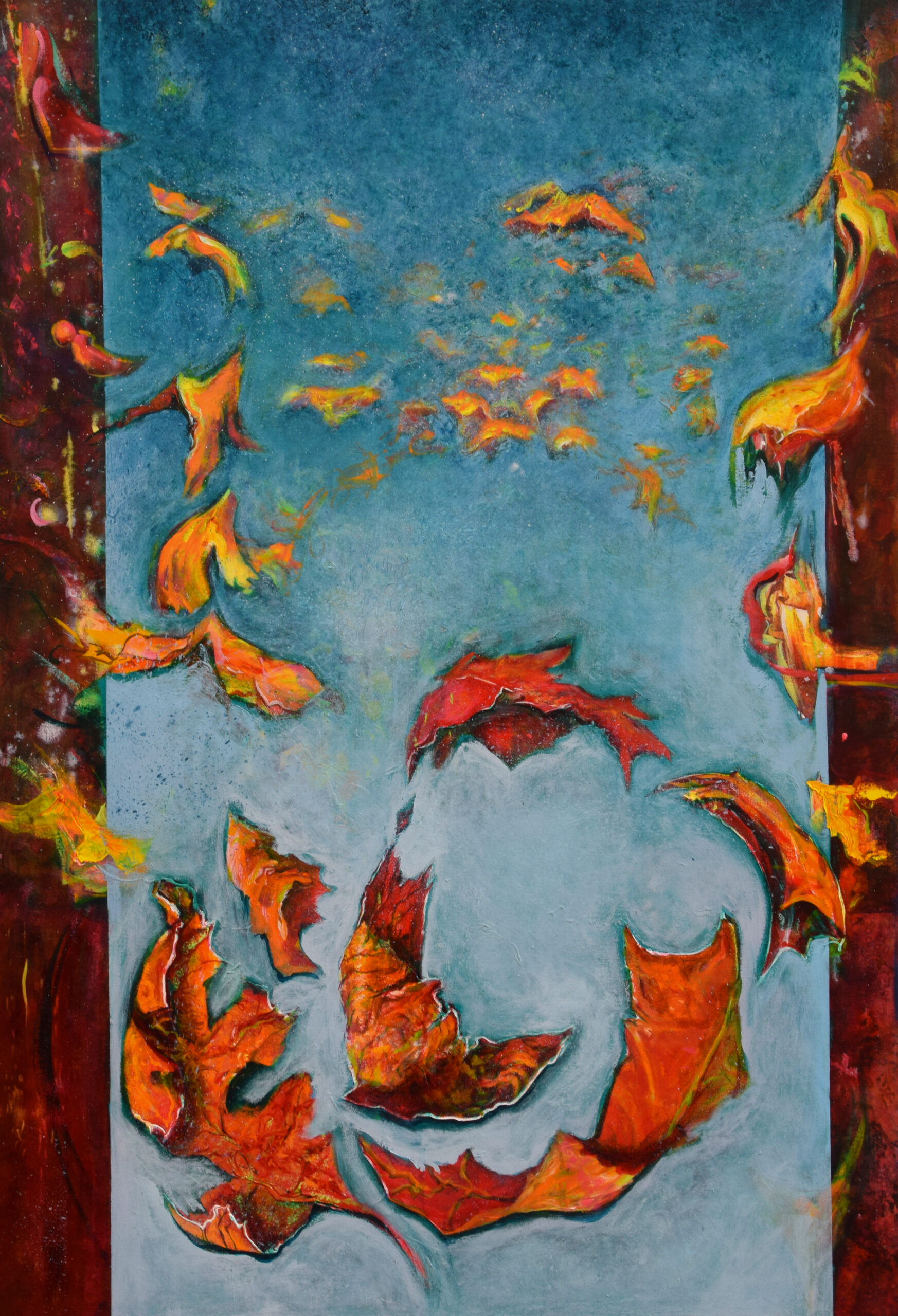The pure joy and energy of Pamela Crockett’s swirling autumn leaves and dried pods bursting with seeds thoroughly upends the idea that the dying back of autumn into winter’s cold is a time of sadness. In her oil paintings on view in the Visitor’s Center at Adkins Arboretum through March 1, this Baltimore artist proves it to be a beautiful, ever-changing period crowning the whole cycle of the year. There will be a reception to meet the artist on Saturday, January 13 from 2 to 4 p.m.

“Seasoning” by Pamela Crockett is among the works on display in So Impotent Our Wisdom, her exhibition of paintings on view at Adkins Arboretum.
Although there are smaller works included in the show, most of Crockett’s paintings are large and powerful. Studying the complex anatomy of plants with the aid of watchmaker’s lenses, she paints their intimate details larger than life and in color so vivid they’re almost scary. As animated as anything in the animal kingdom, a trio of crinkled sycamore leaves waves joyfully as they tumble across the canvas, while segments of sea oat grass recall an inquisitive water creature.
A fragment from a flower bulb on a friend’s coffee table first sparked Crockett’s interest in the cycle of decay.
“In it, I saw an ephemeral beauty,” she said. “The motion of its twisting, curling leaves described the story of its graceful demise. I keep wanting to look closer and closer, as if nature’s secrets and mysteries may reveal themselves if I get in close enough.”
The title of the show, So Impotent Our Wisdom, a phrase drawn from a poem by Emily Dickinson, gives a clue to Crockett’s deeper intent. These paintings are like a call to action. Irrepressibly alive and filled with fascinating details, sometimes including actual seeds or seaweed, they’ll entice you to think about how little we know of this complex and captivating natural world so threatened by human activity.
A veteran teacher of art at several colleges and universities, Crockett is steeped in the craft of paintings and uses its techniques to great effect. She starts each painting by drawing with graphite and colored pencil, then adds color and texture.
“The earliest stages of these oil paintings are very thin layers of colors that display the illusion of texture,” she explained. “I build up in thin layers using a lot of translucent colors. The colors are often applied by stamping with such items as sponges, cheesecloth, bubble wrap, and plastic. As the paintings progress, I build up the forms with actual texture, almost sculpturally.”
Many of the surfaces of Crockett’s paintings seem made by natural forces—the flow of water, the patterns left by the passage of wind, the scattering of seeds or stars across an open field of color. Looking closely, you can never be sure whether you’re seeing the vastness of the cosmos or the infinity of microscopic worlds.
The fleeting quality of the seasons and the fleeting nature of life on earth are captured in the dance of brilliant red oak leaves spinning across the surface of “Seasoning.” Materializing from a seemingly infinite background of blue, they twirl out across narrow bands of deep crimson pressing in from both sides. While the angular curves of the leaves also evoke unfolding flowers and flurries of birds (think autumn flocks and migration), the crimson bands and blue sky are sprinkled with flecks of color and tiny details including occasional strokes of green suggesting newly sprouting plants, a crescent moon and drops of paint that bloom like galaxies.
Far more than simply depicting autumn leaves, “Seasoning” evokes both the cycle of the seasons and the interrelationship of all the elements of the cosmos. Like all the paintings in this show, it will stick in your memory and urge closer consideration of the vitality and fragility of the natural world.
This show is part of Adkins Arboretum’s ongoing exhibition series of work on natural themes by regional artists. It is on view through March 1 at the Arboretum Visitor’s Center located at 12610 Eveland Road near Tuckahoe State Park in Ridgely. Contact the Arboretum at 410-634-2847, ext. 100 or [email protected] for gallery hours.
Adkins Arboretum is a 400-acre native garden and preserve at the headwaters of the Tuckahoe Creek in Caroline County. For more information, visit adkinsarboretum.org.




Write a Letter to the Editor on this Article
We encourage readers to offer their point of view on this article by submitting the following form. Editing is sometimes necessary and is done at the discretion of the editorial staff.